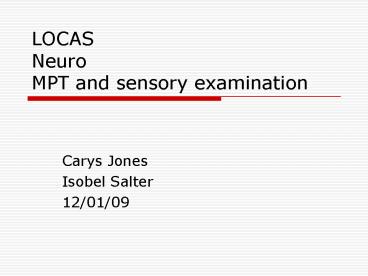LOCAS Neuro MPT and sensory examination - PowerPoint PPT Presentation
1 / 28
Title:
LOCAS Neuro MPT and sensory examination
Description:
Ask them to relax their arms, and check tone. ... Biceps (C5) Supinator (C6) Triceps (C7) Remember reinforcement before you give up! ... – PowerPoint PPT presentation
Number of Views:198
Avg rating:3.0/5.0
Title: LOCAS Neuro MPT and sensory examination
1
LOCASNeuroMPT and sensory examination
- Carys Jones
- Isobel Salter
- 12/01/09
2
Contents
- Motor system
- Sensory
- Interpretation and questions
- Parkinsons
- Demonstration!
3
To start.
- Smile and be nice!
- Introduce, check identity, consent, expose
- Wash hands!
- General inspection
- Speech and posture
- Look around the bed for clues!
- Inspection
- Muscle wasting, fasciculations, involuntary
movements e.g. tremor, chorea, myoclonus.
4
Tone- upper limb
- Arms outstretched in supination to check for
pronator drift. - Ask them to relax their arms, and check tone.
- Feel for spasticity, cogwheeling, and clasp-
knife and leadpipe rigidity.
5
Power- Grading
- 0- No muscle contraction visible
- 1- Flicker of contraction but no movement
- 2- Joint movement when effect of gravity elimited
- 3- Movement against gravity but not against
examiner's resistance - 4- Movement against resistance but weaker than
normal - 5- Normal power
6
Power- upper limbs
- Start proximally
- Shoulders abduction and adduction
- Elbows- flexion and extension
- Wrists- flexion and extension
- Fingers- abduction, adduction, extension and
flexion. - Thumb- abduction and opposition
7
Nerve roots- upper limbs
- A quick check of nerve roots
- C5 shoulder abduction
- C6 elbow flexion (half supinated)
- C7 wrist extension
- C8 finger flexion
- T1 finger abduction
8
Reflexes- upper limb
- Biceps (C5)
- Supinator (C6)
- Triceps (C7)
- Remember reinforcement before you give up!
9
Coordination- upper limb
- Finger- nose test
- Test for
- dysdiadochokinesis
10
Extra bits for upper limb
- Ulnar nerve Ulnar MAFIAS
- M Medial lumbricals weak- priests blessing
- A Adductor pollicis weak- Froments sign
- F First dorsal interosseous wasting
- I Interossei weak and wasted
- A Abduction little finger weak
- S Sensory loss over small and ulnar half ring
finger.
11
- Median nerve
- Thenar eminence
- LOAF 1st and 2nd Lumbricals
- Opponens pollicis
- Abductor Pollicis brevis
- Flexor pollicis longus
- Sensory disturbance thumb and 2.5 fingers
12
Tone- Lower limb
- Ask pt to relax
- Roll the leg and look at the foot
- Lift the knee into flexed position and let go
- Remember to test for clonus! More than 3 beats-
abnormal.
13
Power- Lower limb
- Grading as previously
- Hip- flexion, extension, abduction and adduction.
- Knee- flexion and extension
- Ankle- Dorsiflexion, plantar flexion, inversion,
eversion. - Big toe- extension
14
Nerve roots- Lower limbs
- Quick check
- L2 Hip flexion
- L3 Knee extension
- L4 Ankle dorsiflexion
- L5 Big toe extension
- S1 Ankle plantar flexion
15
Reflexes- Lower limbs
- Knee (L3/4)
- Ankle (S1/2)
- Plantar response
- Reinforcement
16
Coordination- lower limbs
- Heel-shin test.
- As an extra, you may test gait and Rombergs
(proprioception) - Gait- posture, arm swing, step size,
circumduction, ataxia
17
Testing sensation
- Know dermatomes!
- Test each side simultaneously.
- Light touch- cotton wool.
- Pain- neuro-tip (dispose in sharps bin!!)
- Temperature
- Vibration- start distally on bony points
- Proprioception- JPS
18
Presenting your findings
- Thank the patient- remember to cover them up.
- To complete the examination I would like to
examine the lower limbs, gait, sensory system and
cranial nerves.
19
- Turn to examiner This is a 60 yr old lady. On
general inspection she is comfortable at rest and
alert. She has a visible resting tremor. On motor
examination of the upper limbs she has increased
tone in both arms with cogwheeling. There were no
other abnormal findings.
20
Interpretation of signs
- Locate the lesion.
- UMN or LMN?
- Cerebellar D dysdiadochokinesis
- A ataxia
- N nystagmus
- I intention tremor
- S slurred speech
- H hypotonia
21
- Think systematically
22
Be prepared for questions
- After locating the lesion
- Differentials remember common things are common!
- Underlying pathology- brief.
- Basic management.
23
Parkinsons disease
- Common and has some distinctive signs
- TRAP T- tremor
- R- rigidity
- A- akinesia/ bradykinesia
- P- postural instability
24
PD- inspection
- Mask-like expression
- Flexed extrapyramidal position gun- slinger
position - Loss of arm swing
- Hesitancy
- Shuffling
- Festination (hurrying)
- Retropulsion
25
PD
- Tremor- pill rolling and resting
- Voice- quiet and monotonous
- Bradykinesia
- Increased tone- rigidity
- Lead pipe
- Cog wheeling
- Glabellar tap response
26
PD- Questions
- Pathology- loss of dopaminergic cells in
substantia nigra of basal ganglia - Treatment- dopamine agonists, levodopa, COMT and
MAO type B inhibitors. - MDT approach!!
27
Summary
- Start off with a smile and good intro etc
- Dont hurt the patient
- Take your time
- Be systematic
- Dont panic
- Practice, practice, practice!
28
- GOOD LUCK!































